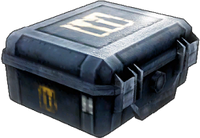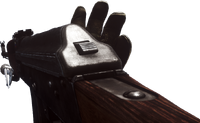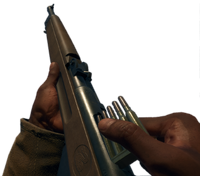| This article is a stub. It is short and in need of fortification. Why not help out? |

Ammunition refers to the materials needed to fire a weapon. The Battlefield series, being a first-person shooter series with a real-life setting, has mechanics for ammunition and reloading that mirror real life behaviors.
Ammunition
There are two ammo values, magazine ammunition and reserve ammunition. They both have their own capacities which they cannot exceed.
Magazine
Loaded ammunition is the amount of ammo in the player's weapon. When a weapon fires, it subtracts ammo from this value. When the value reaches zero, the weapon cannot fire and must be reloaded.
Reserve
Reserve ammunition is the amount of ammo carried by the player but outside of the player's magazine. When the player is resupplied, this value is increased. When the player reloads, this value decreases.
When the player's magazine is not full, the resupplied ammo can go over the reserve limit, just enough so that the player's magazine will be full when reloaded.
Magazine-Based Reserve
In earlier games and Hardcore mode of Battlefield 4, reserve ammunition is tracked by magazines instead of a pool of ammo. Reloading mid-magazine will discard the magazine and any rounds remaining in the magazine, and load another new magazine. Resupplying also works via magazines.
Reloading
Reloading is performed by pressing the Reload key, which will perform a reload animation and refill a weapon to its maximum capacity. In games after Battlefield 1942, it is also automatically triggered when the player's current magazine is emptied (the reload must be manually initiated in Battlefield 1942).
From Bad Company onwards, a player can reload while falling or sprinting, and these actions do not interrupt the reload.
In earlier games, reserve ammo is counted in magazines. Reloading mid-magazine will dispose of any rounds remaining in the initial magazine and load in a new full magazine. This mechanic is also used in Hardcore for Battlefield 4, in addition to tracking chambered rounds (see below).
In later games (from Battlefield: Bad Company onwards), reserve ammo is counted in a single "pool", subtracting the amount of ammo needed to fill up the magazine from the player's reserve ammo. This represents the player character moving any rounds remaining in their magazine back into their reserves and getting a fresh magazine from their reserves.
For the vast majority of weapons in the Battlefield series, reloading is done in one motion, where one magazine is swapped out for a full one, or when one en-bloc clip is replaced with another, or when a break-action or swing-out revolver ejects all of its rounds and refilled to full with a speedloader or a moon clip.
In Battlefield 2, a small meter at the bottom of the ammo tab on the HUD will fill to signify the reload progressing.
Empty Reload

Cocking the RPK after an empty reload.
In Battlefield games since Battlefield 3, many closed bolt weapons track a chambered round and require an additional weapon chambering step when reloading from empty. Earlier games (including the Bad Company games) instead feature a single reload animation regardless of the state of the weapon.
For these weapons, a round needs to be removed from the magazine and chambered in order for it to fire. This means that the maximum capacity of the weapon is the magazine capacity + 1 chambered round.
When reloading from empty, the empty magazine replaced, and the weapon is chambered, slightly increasing the length of the reload animation. In this case, the weapon holds the amount of ammo inside a full magazine. Because one round has been removed from the magazine and fed into the weapon, the player can reload again in this state, replacing the one-round-less magazine with a full one, adding another round to the weapon and allowing it to reach its maximum capacity.
When reloading from non-empty, the partially spent magazine is replaced. Because there is still a round chambered in the weapon, the weapon does not need to be chambered, and the amount of ammo in the weapon is 1 + the capacity of the magazine.
In both official and non-official weapon stats, a "+1" is seen in magazine size to indicate a weapon's ability to carry a chambered round.
Single Round

Chamberloading the SPAS-12.

Loading a round into the SPAS-12's magazine tube.
Many older weapons and shotguns do not have detachable magazines and needs to have their rounds loaded individually. Shotguns and some older revolvers for example use gate-loading, where individual rounds are fed through a port.
The reloading animation involves a looped animation of single rounds being loaded into the weapon, incrementing the magazine ammo by 1 every motion. Very often, it is possible to interrupt the reload when the magazine isn't full yet to return fire.
For shotguns, this often also involves a chamber loading process, where when the shotgun is empty, the first round is fed directly into the chamber instead of first being loaded into the magazine tube. This often comes in the form of a special chamber loading animation when reloading the first round from empty.
The Nagant Revolver is notable for being a gate-loading revolver that can reload by disassembling the gun and replacing the cylinder, allowing it to be both reloaded in a single action and round-by-round.
The pump-action shotguns in Battlefield 1 do not chamberload, do not track + 1, and their reloads cannot be interrupted. Their reload animations instead involve filling up their tube magazine and pumping once to chamber the weapon.
Stripper Clips

Loading a 5-round stripper clip into the Cei-Rigotti. The Cei-Rigotti holds 10 rounds in its internal magazine, requiring two stripper clips to reload from empty.

Reloading the Cei-Rigotti with single rounds.
Battlefield 1 added mechanics for stripper clips. Stripper clips are individual clips of ammunition that can quickly load several rounds into a weapon's fixed magazine. They are used alongside individually reloaded rounds.
A clip has a fixed size for a weapon, usually around 5 rounds. The player always loads clips first, before topping off the magazine with individual rounds when the size of the clip exceeds the amount of empty space in the magazine. If the player doesn't have enough ammo for a clip, the player will load individual rounds.
The Repetierpistole M1912 uses stripper clips, but game mechanics require the reload to first dump out all remaining rounds in the magazine, making it functionally a single-step reload.
Dynamic Reload
Some weapons in Battlefield 1 have more varied reload animations that change depending on the amount of ammunition remaining in the magazine.
Many machine guns in Battlefield 1 use non-disintegrating links, which means that they must have their ammo belt retracted before they can be reloaded. The amount of time spent retracting the ammo belt increases as the amount of ammo remaining in the magazine decreases, since there is a longer trail of spent ammo belt.
The Mosin-Nagant M91 and the Obrez Pistol have multiple animations, one for each possible value of ammo in the magazine.
For some rifles in Battlefield 1, when reloading with one round remaining, the player character will eject that round and load in a new full stripper clip of ammo.
The Perino Model 1908 has a hopper magazine that holds six 20-round ammo strips. It has two states of reload: pressing Reload when some or all strips were fully spent will refill strips, topping off the hopper magazine to six ammo strips (with at least 101 rounds). If the hopper holds six strips and the current strip is only partially spent, pressing Reload will replace the current strip, fully topping off the magazine. An empty reload will still require a weapon cock after loading in the first strip.
The Model 1900, a double barreled shotgun, has two reload animations for when there is 1 or no round left.
Interrupting
In earlier games, large explosions affecting the player or entering a vehicle will immediately cease the reloading process, forcing the player to restart. They are also only complete when the entire animation had run its course, making it impossible to skip any part of the animation.
The later games in the Battlefield series tracks the individual steps in a reload. If the player interrupts any step (by going prone for example), the game will remember that step and resume when the player returns to the reload.
Reload Canceling
From Battlefield: Bad Company onwards, the weapon's ammunition is typically restored before the reload animation completes, creating a small delay between when the game registers that a weapon is refilled, and when the player can fire the weapon.
Players can skip the delay by reload canceling, typically by switching to a handgun or gadget then switching back. The weapon will still have registered its full reloaded ammo, but be immediately ready to fire when switching back. One notable example is the Lebel Model 1886, which has a significant post-reload time.
Weapons like the SMAW and RPG-7V2 can save time via double reload canceling. Although canceling reload on the XBOW requires the full sequence to be redone, swapping ammunition is quickly done when the XBOW is drawn.
Vehicle Ammunition
Vehicles and emplaced weapons in the Battlefield series almost always have infinite ammunition. Emplaced weapons and vehicle machine guns often have infinite loaded ammo, requiring no reload and can be fired infinitely. These weapons use cooldown mechanics instead, where prolonged fire will result in the weapon being temporarily disabled.
Vehicle weapons often use a format similar to infantry weapons, where a reserve ammunition pool is present and the weapon requires reload after depleting its magazine. However, vehicles regenerate reserve ammunition on a timer.
In Battlefield V, planes resupply only when they fly through a resupply point.
Battlefield V: Firestorm
In Firestorm, ammunition for weapons must be looted from the ground around Halvøy. It comes in five specific classes - pistol, submachine gun, rifle, machine gun, sniper and shotgun.
Vehicle Ammunition is another item type that is used to resupply vehicles. It comes in two forms, light and heavy - the former used to regenerate secondary vehicle armament such as machine guns and the latter used to refill the main gun or cannon.
| |||||||||||||||||
